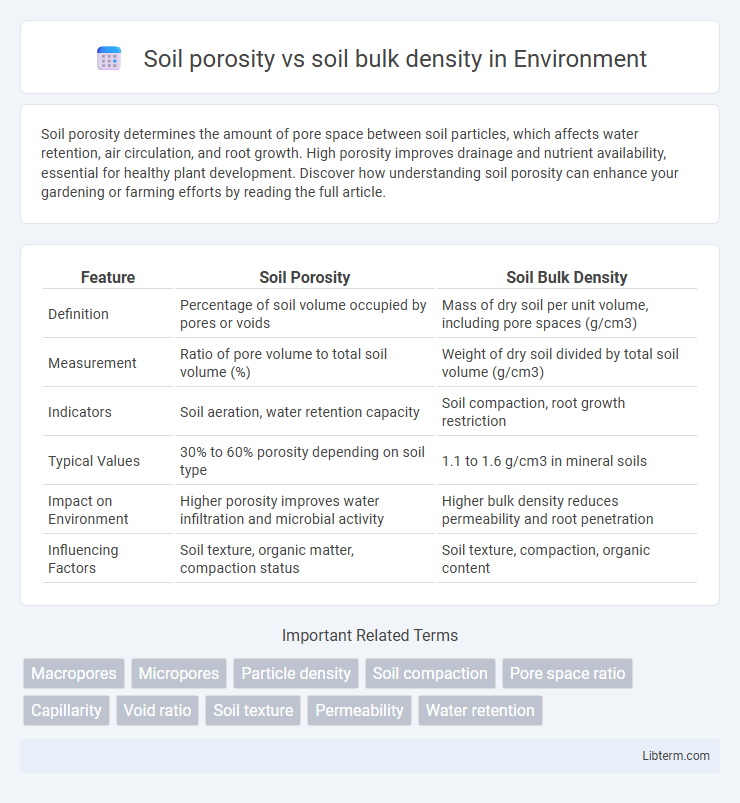Soil porosity determines the amount of pore space between soil particles, which affects water retention, air circulation, and root growth. High porosity improves drainage and nutrient availability, essential for healthy plant development. Discover how understanding soil porosity can enhance your gardening or farming efforts by reading the full article.
Table of Comparison
| Feature | Soil Porosity | Soil Bulk Density |
|---|---|---|
| Definition | Percentage of soil volume occupied by pores or voids | Mass of dry soil per unit volume, including pore spaces (g/cm3) |
| Measurement | Ratio of pore volume to total soil volume (%) | Weight of dry soil divided by total soil volume (g/cm3) |
| Indicators | Soil aeration, water retention capacity | Soil compaction, root growth restriction |
| Typical Values | 30% to 60% porosity depending on soil type | 1.1 to 1.6 g/cm3 in mineral soils |
| Impact on Environment | Higher porosity improves water infiltration and microbial activity | Higher bulk density reduces permeability and root penetration |
| Influencing Factors | Soil texture, organic matter, compaction status | Soil texture, compaction, organic content |
Introduction to Soil Porosity and Bulk Density
Soil porosity refers to the volume of pore spaces between soil particles, directly influencing water retention, air movement, and root growth. Soil bulk density measures the mass of soil per unit volume, indicating soil compaction levels and affecting root penetration and water infiltration. Understanding the inverse relationship between high soil bulk density and low porosity is essential for optimizing soil health and plant productivity.
Defining Soil Porosity
Soil porosity refers to the percentage of void spaces or pores within soil, allowing air and water movement essential for root growth and microbial activity. It is inversely related to soil bulk density, which measures the mass of soil per unit volume and indicates compaction levels. High soil porosity typically corresponds to lower bulk density, enhancing soil aeration and water infiltration.
Understanding Soil Bulk Density
Soil bulk density measures the mass of soil per unit volume, indicating soil compaction and porosity. Higher bulk density values typically correspond to lower soil porosity, reducing air and water movement essential for root growth. Understanding soil bulk density helps evaluate soil health, compaction levels, and suitability for agricultural practices.
Factors Affecting Soil Porosity
Soil porosity, the volume of pore spaces between soil particles, directly influences soil bulk density, which is the mass of soil per unit volume including those pores. Factors affecting soil porosity include soil texture, organic matter content, compaction level, and soil structure, with sandy soils typically having lower porosity compared to clay soils due to particle size differences. Higher organic matter increases porosity by creating more aggregates, while compaction reduces pore space, leading to increased bulk density and reduced water infiltration.
Factors Influencing Soil Bulk Density
Soil bulk density is primarily influenced by soil texture, organic matter content, and compaction levels, with finer textures and higher organic content generally reducing bulk density. Soil porosity inversely correlates with bulk density, as increased bulk density typically results in decreased pore space, affecting water retention and root growth. Management practices, moisture conditions, and soil structure also play critical roles in modifying soil bulk density and consequently soil porosity.
Relationship Between Soil Porosity and Bulk Density
Soil porosity and bulk density share an inverse relationship, where increased soil porosity leads to decreased bulk density due to the greater volume of air spaces within the soil matrix. Bulk density quantifies the mass of soil per unit volume, including solids and pore spaces, making it a critical indicator of soil compaction and health. High soil porosity enhances water retention and root penetration, while elevated bulk density can restrict air and water movement, negatively impacting plant growth.
Importance of Soil Porosity in Agriculture
Soil porosity, the measure of void spaces in soil, directly influences water retention, root penetration, and aeration, which are critical for crop growth and yield. Higher soil porosity improves soil structure, promoting better oxygen flow and nutrient availability essential for healthy plant development. Maintaining optimal soil porosity reduces soil compaction, enhances microbial activity, and supports sustainable agricultural productivity.
Impact of Bulk Density on Soil Health
High soil bulk density reduces pore space, limiting soil porosity and restricting oxygen availability, which adversely affects root growth and microbial activity essential for nutrient cycling. Compacted soils with elevated bulk density hinder water infiltration and retention, increasing runoff and erosion risks while decreasing overall soil fertility. Maintaining optimal bulk density is critical for preserving soil structure, enhancing aeration, and supporting sustainable crop production.
Methods to Measure Soil Porosity and Bulk Density
Soil porosity and bulk density are commonly measured using core sampling and volumetric analysis, where soil cores are extracted to determine the volume of pores versus solid particles. The gravimetric method involves drying soil samples to calculate bulk density by dividing the dry mass by the total volume, while porosity is derived from bulk density and particle density values. Advanced techniques such as X-ray computed tomography and nuclear magnetic resonance provide non-destructive, high-resolution assessments of soil pore structure and density.
Strategies to Improve Soil Structure and Function
Improving soil structure and function requires increasing soil porosity and reducing soil bulk density through practices such as organic matter incorporation, cover cropping, and reduced tillage. Organic amendments like compost enhance aggregation, promoting pore space that facilitates root growth and water infiltration. Maintaining diverse vegetation cover supports soil biota, which helps stabilize aggregates and maintain optimal bulk density for nutrient cycling and crop productivity.
Soil porosity Infographic

 libterm.com
libterm.com